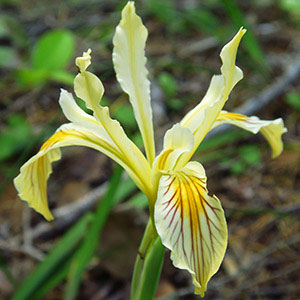Iris tenax
Iris bracteata
Oregon flag, Oregon iris, tough-leaf iris
Siskiyou iris
many-branched, not creeping, forming dense clumps, slender, 0.3–0.8 cm diam.;
roots fibrous.
sheathed with old leaf bases, slender, 0.6–0.9 cm diam.;
roots few, fibrous.
simple, somewhat angular, solid, 1.5–2.7 dm.
simple, solid, 1.5–3 dm.
basal somewhat lax, overtopping stem, blade light green, paling to pink or straw color basally, finely ribbed, linear-acute to linear, ensiform, 4.5 dm × 0.5 cm, margins not thickened;
cauline 1–3, sheathing for 1/2 length then spreading, foliaceous, blade linear-lanceolate, not inflated, narrow, reduced, to 15 cm.
basal with abaxial surface of blades deep glossy green on one side of fan, light yellow-green on other side, pink or red-tinged basally, strongly ribbed, 4–6 dm × 0.8–1 cm, rigid, margins not thickened;
cauline 3–6, imbricated, closely sheathing stem ca. 2/3 length, spreading distally, bractlike, blade inflated, often shorter than basal leaves.
1–2-flowered;
spathes distant basally by 3 cm in some cases, keeled, linear-lanceolate to lanceolate-acuminate, 5–7 cm × 2–4 mm, unequal, outer longer than inner, herbaceous, margins scarious.
simple, units 1–2-flowered;
spathes closed tightly around pedicel and ovary, lanceolate, 5.2–9 cm × 6–8 mm, subequal, herbaceous, margins scarious, apex acuminate.
perianth color variable, purple, pink, lavender, cream, yellow, or rarely white;
floral tube funnelform, 0.6–2 cm;
sepals veined with color of limb, obovate, 5.8–6 × 1.6–2 cm, base gradually attenuate into white claw with slight yellow ridge, apex emarginate to bluntly rounded;
petals same color as sepals, not prominently veined, lanceolate to oblanceolate, 5 × 1 cm;
ovary 1–2 cm, slightly wider distally, base very gradually attenuate;
style 2.2–3.2 cm, crests subquadrate, 8–12 mm, margins crenate or incised;
stigmas triangular, margins entire;
pedicel 1–5 cm, longer in second flower (when present) than in first.
perianth cream to buff-yellow;
floral tube 0.8–0.9 cm;
sepals with deeper yellow signal, veined with purple or brown, obovate-lanceolate, 6.5 × 2.5 cm, base gradually attenuate into wide claw;
petals narrowly oblanceolate, 7–9 × 0.8–2 cm, base gradually attenuate;
ovary nearly circular in cross section, 1.5–2.5 cm, base gradually attenuate into pedicel, apex abruptly acuminate into floral tube;
style 2.2–3 cm, crests spreading, yellow, not veined, 1.2 × 0.9–1.7 cm, margins toothed;
stigmas triangular or tongue-shaped, margins entire;
pedicel 3–6.2 cm.
oblong, triangular in cross section, prominently ribbed, beaked, 3–5 cm.
nearly circular in cross section, tapering abruptly at each end, 2–2.5 × 1–1.5 cm.
brown, D-shaped to irregular, wrinkled.
dark brown, irregular in shape, wrinkled.
= 40.
Iris tenax
Iris bracteata
Plants described as subsp. klamathensis differ from others of the species in having floral tubes 11–20 mm instead of 6–10 mm, style crests somewhat longer and narrower, and flower color and markings more like those of Iris bracteata or I. innominata. The latter species has an even longer floral tube, 15–30 mm, which could be evidence of introgression. Hybrids are known to occur in the area common to both species, in Douglas County, Oregon.
Iris tenax hybridizes with I. bracteata, I. chrysophylla, I. douglasiana, I. hartwegii, I. innominata, I. macrosiphon, I. purdyi, and I. tenuissima.
(Discussion copyrighted by Flora of North America; reprinted with permission.)
Iris bracteata is limited to one county each in northern California and southern Oregon. It hybridizes with I. chrysophylla, I. douglasiana, I. innominata, I. munzii, I. purdyi, and I. tenax.
(Discussion copyrighted by Flora of North America; reprinted with permission.)


